Effect of Fiber Content on Mechanical Properties of Fiber-Reinforced CGF All-Solid-Waste Binder-Solidified Soil
Abstract
:1. Introduction
2. Materials and Methods
2.1. Materials
2.1.1. Test Soil
2.1.2. CGF Binder and Polypropylene Fiber
2.2. Testing Equipment
2.2.1. Uniaxial Tensile Test Equipment
2.2.2. Unconfined Compressive Strength Test Equipment
2.3. Testing Program
2.4. Sample Preparation Method
3. Results and Discussion
3.1. Deformation Characteristics
3.1.1. Stress–Strain Relationship and Failure Mode
3.1.2. Determination Method of Strength, Residual Strength and Modulus
3.1.3. Tensile Modulus and Deformation Modulus
3.1.4. Fracture Energy
3.2. Strength Characteristics
3.2.1. Influence of Fiber Content on Unconfined Compressive Strength
3.2.2. Influence of Fiber Content on Uniaxial Tensile Strength
3.3. Relationship between Tensile–Compression Ratio of Strength and Fiber Content
3.4. Micromechanisms
3.4.1. Microscopic Morphology
3.4.2. Fiber–Binder Coupling Reinforcement Mechanism
- Gelling and filling effect of CGF: In the alkaline environment formed by the dissolution of a large amount of OH− from CCR in contact with water, GGBS and FA undergo the pozzolanic reaction to generate hydration products such as C-A-H, C-S-H and C-A-S-H [33,34], which can gel the soil particles and fibers, fill the pore spaces in the soil and increase the density of the soil, increasing the strength of solidified soil.
- Embedding and bridging effect of fibers: The enhancement effect of fibers on the strength of solidified soil depends on the mechanical interaction between fibers and the interface of the solidified soil matrix. As the hydration products of CGF have strong gelling properties, they attached to the fiber surface to form a layer of hard shell, which effectively enhanced the stiffness of the fiber. At the same time, the crystals attached to the fiber surface and the hydration products inside the solidified soil combined with each other, resulting in the overall firm embedding of the fiber in the solidified soil. Due to the large difference in the modulus of elasticity between the fiber and the solidified soil, the difference in deformation between the two produces relative displacement; thus, the originally smooth fiber surface attaches to the solidified soil particles, resulting in its surface roughness and unevenness, which increases the occlusal force of the fiber–solidified soil interface and improves the ability of the fiber to bear tensile stress. Under the action of external forces, the interface forces of adhesion and friction can inhibit the fiber’s slip in the solidified soil, preventing the fiber from being pulled out. When the external force continues to increase, the soil body becomes damaged, and fiber plays a “bridging” role through the fracture surface to inhibit the expansion of the damaged surface; when the external force exceeds the force in the fiber-solidified soil interface or the fiber’s own strength, then the fiber will be pulled out of the soil. When the external force exceeds the force at the fiber-solidified soil interface or the strength of the fiber itself, the fiber on the fracture surface will be pulled out or broken, and the reinforcing effect of the fiber will be completely lost [42,43,44].
- Spatial network structure: When the optimal fiber content (0.25%) is used in the CGF-solidified soil, the fibers cross and overlap each other inside the soil, presenting a randomly distributed mesh structure. When one or more bundles of fibers in the mesh structure are subjected to relative movement with the solidified soil, the fibers overlapping with them will transfer and disperse the stresses in different directions and improve the overall strength of the solidified soil [45]. However, when the fiber content is too high, the excess fiber will be unevenly distributed in the solidified soil and knotted into a ball, resulting in the existence of “weak areas” in the soil but also damage to the structure of the soil, thus reducing its strength [46].
4. Conclusions
- Compared with the nonfiber-solidified soil, the unconfined compressive strength, uniaxial tensile strength, deformation modulus, tensile modulus, fracture energy and residual strength of the fiber-reinforced CGF-solidified soil are significantly improved. Compared with the solidified soil without fiber, the fracture energy of the fiber-reinforced CGF-solidified soil can be increased by 130.1–171.7%, the deformation modulus can be increased by 102.1–130.1% and the tensile modulus can be increased by 112.9–158.7%. The increased amplitudes of the tensile strength and tensile modulus are greater than those of the compressive strength and deformation modulus, respectively. The addition of fiber makes the failure mode of the CGF-solidified soil transition from typical brittle failure to plastic failure.
- The compressive strength and tensile strength of the polypropylene-fiber-reinforced CGF-solidified soil increased and then decreased with the increase in fiber content, and both reached their maximum values when the fiber content was 0.25%. The tensile strength is 905.9 kPa, which is 186.6% higher than that of the solidified soil without fiber, and the compressive strength is 3985.7 kPa, which is 116.6% higher than that of the solidified soil without fiber. However, both the compressive residual strength and tensile residual strength increased continuously with the increase in fiber content, and there was no optimal content.
- The modulus tensile–compression ratio and strength tensile–compression ratio of the fiber-reinforced CGF-solidified soil both increased and then decreased with the increase in fiber content, reaching the maximum at 0.25% fiber content. The modulus tensile–compression ratio is 0.109 and the strength tensile–compression ratio is 0.227. The incorporation of fiber effectively improved the toughness and stiffness of the solid soil.
- The fiber-CGF coupling effect is mainly embodied by two processes: first, the gelling and filling effect of the hydration products generated by CGF, enhancing the compactness of the soil body and then enhancing the strength of the soil body; second, the one-dimensional embedding and bridging effect of the fibers and the three-dimensional spatial mesh structure, resulting in a combination of friction and adhesion, preventing the development of cracks and enhancing the ability of the soil body to resist deformation.
Author Contributions
Funding
Institutional Review Board Statement
Informed Consent Statement
Data Availability Statement
Acknowledgments
Conflicts of Interest
References
- Li, S.C.; Yang, J.J.; Wu, Y.L.; Wang, M. Research on tensile characteristics of cement-treated soft soil. J. Cent. South Univ. Sci. Technol. 2022, 53, 2619–2632. [Google Scholar]
- Wang, Y.S.; Liu, Z.Q.; Wan, W.L.; Nie, A.H.; Zhang, Y.W.; Han, C.P. Toughening effect and mechanism of rice straw Fiber-reinforced lime soil. Constr. Build. Mater. 2023, 393, 132133. [Google Scholar] [CrossRef]
- Lu, L.F.; Ma, Q.; Hu, J.; Li, Q.F. Mechanical Properties, Curing Mechanism, and Microscopic Experimental Study of Polypropylene Fiber Coordinated Fly Ash Modified Cement-Silty Soil. Materials 2021, 14, 5441. [Google Scholar] [CrossRef] [PubMed]
- Akbari, H.R.; Sharafi, H.; Goodarzi, A.R. Effect of polypropylene fiber and nano-zeolite on stabilized soft soil under wet-dry cycles. Geotext. Geomembr. 2021, 49, 1470–1482. [Google Scholar] [CrossRef]
- Pradhan, P.K.; Kar, R.K.; Naik, A. Effect of Random Inclusion of Polypropylene Fibers on Strength Characteristics of Cohesive Soil. Geotech. Geol. Eng. 2012, 30, 15–25. [Google Scholar] [CrossRef]
- Yuan, T.; Lei, X.W.; Ai, D.; An, R.; Chen, C.; Chen, X. Strength characteristics of expansive soil improved by coir fiber-MICP composite. J. Water Resour. Archit. Eng. 2023, 21, 105–111. [Google Scholar]
- Sindhu Nachiar, S.; Anandh, S.; Ahamed Sarjune, N.; Kumaresan, M. Effect of steel fiber in SIFCON using GGBS as binder replacement. Mater. Today Proc. 2023, 93, 1–8. [Google Scholar] [CrossRef]
- Divya, P.V.; Viswanadham, B.V.S.; Gourc, J.P. Evaluation of Tensile Strength-Strain Characteristics of Fiber-Reinforced Soil through Laboratory Tests. J. Mater. Civ. Eng. 2014, 26, 14–23. [Google Scholar] [CrossRef]
- Coviello, C.G.; Lassandro, P.; Sabbà, M.F.; Foti, D. Mechanical and Thermal Effects of Using Fine Recycled PET Aggregates in Common Screeds. Sustainability 2023, 15, 16692. [Google Scholar] [CrossRef]
- Cai, Y.; Shi, B.; Gao, W.; Chen, F.J.; Tang, Z.S. Experimental study on engineering properties of fiber-lime treated soils. Chin. J. Geotech. Eng. 2006, 28, 1283–1287. [Google Scholar]
- Shukla, S.; Sivakugan, N.; Das, B. Fundamental concepts of soil reinforcement—An overview. Int. J. Geotech. Eng. 2009, 3, 329–342. [Google Scholar] [CrossRef]
- Prabakar, J.; Sridhar, R.S. Effect of random inclusion of sisal fibre on strength behaviour of soil. Constr. Build. Mater. 2002, 16, 123–131. [Google Scholar] [CrossRef]
- Wang, D.X.; Wang, H.W.; Larsson, S.; Benzerzour, M.; Maherzi, W.; Amar, M. Effect of basalt fiber inclusion on the mechanical properties and microstructure of cement-solidified kaolinite. Constr. Build. Mater. 2020, 241, 118085. [Google Scholar] [CrossRef]
- Hejazi, S.M.; Sheikhzadeh, M.; Abtahi, S.M.; Zadhoush, A. A simple review of soil reinforcement by using natural and synthetic fibers. Constr. Build. Mater. 2012, 30, 100–116. [Google Scholar] [CrossRef]
- Ghavami, K.; Toledo Filho, R.D.; Barbosa, N.P. Behaviour of composite soil reinforced with natural fibres. Cem. Concr. Compos. 1999, 21, 39–48. [Google Scholar] [CrossRef]
- Mahattanatawee, K.; Manthey, J.A.; Luzio, G.; Talcott, S.T.; Goodner, K.; Baldwin, E.A. Total antioxidant activity and fiber content of select Florida-grown tropical fruits. J. Agric. Food Chem. 2006, 54, 7355–7363. [Google Scholar] [CrossRef]
- Bouaricha, L.; Henni, A.D.; Lancelot, L. A Laboratory Investigation On Shear Strength Behavior Of Sandy Soil: Effect Of Glass Fiber And Clinker Residue Content. Stud. Geotech. Mech. 2017, 39, 3–15. [Google Scholar] [CrossRef]
- Tang, C.S.; Li, H.; Pan, X.H.; Yin, L.Y.; Cheng, L.; Cheng, Q.; Liu, B.; Shi, B. Coupling effect of biocementation-fiber reinforcement on mechanical behavior of calcareous sand for ocean engineering. Bull. Eng. Geol. Environ. 2022, 81, 163. [Google Scholar] [CrossRef]
- Consoli, N.C.; Bassani, M.A.A.; Festugato, L. Effect of fiber-reinforcement on the strength of cemented soils. Geotext. Geomembr. 2010, 28, 344–351. [Google Scholar] [CrossRef]
- Rostami, R.; Zarrebini, M.; Mandegari, M.; Mostofinejad, D.; Abtahi, S.M. A review on performance of polyester fibers in alkaline and cementitious composites environments. Constr. Build. Mater. 2020, 241, 117998. [Google Scholar] [CrossRef]
- Sabbà, M.F.; Tesoro, M.; Falcicchio, C.; Foti, D. Rammed Earth with Straw Fibers and Earth Mortar: Mix Design and Mechanical Characteristics Determination. Fibers 2021, 9, 30. [Google Scholar] [CrossRef]
- Duan, X.L.; Zhang, J.S. Mechanical Properties, Failure Mode, and Microstructure of Soil-Cement Modified with Fly Ash and Polypropylene Fiber. Adv. Mater. Sci. Eng. 2019, 2019, 9561794. [Google Scholar] [CrossRef]
- Marvila, M.T.; Rocha, H.A.; de Azevedo, A.R.G.; Colorado, H.A.; Zapata, J.F.; Vieira, C.M.F. Use of natural vegetable fibers in cementitious composites: Concepts and applications. Innov. Infrastruct. Solut. 2021, 6, 180. [Google Scholar] [CrossRef]
- Anggraini, V.; Asadi, A.; Huat, B.B.K.; Nahazanan, H. Effects of coir fibers on tensile and compressive strength of lime treated soft soil. Measurement 2015, 59, 372–381. [Google Scholar] [CrossRef]
- Duong, N.T.; Tran, K.Q.; Satomi, T.; Takahashi, H. Effects of agricultural by-product on mechanical properties of cemented waste soil. J. Clean. Prod. 2022, 365, 132814. [Google Scholar] [CrossRef]
- Miller, C.J.; Rifai, S. Fiber reinforcement for waste containment soil liners. J. Environ. Eng.-Asce 2004, 130, 891–895. [Google Scholar] [CrossRef]
- Kakooei, S.; Akil, H.M.; Jamshidi, M.; Rouhi, J. The effects of polypropylene fibers on the properties of reinforced concrete structures. Constr. Build. Mater. 2012, 27, 73–77. [Google Scholar] [CrossRef]
- Li, Q.; Chen, J.H.; Hu, H.X. The tensile and swelling behavior of cement-stabilized marine clay reinforced with short waste fibers. Mar. Georesour. Geotechnol. 2019, 37, 1236–1246. [Google Scholar] [CrossRef]
- Kumar, A.; Walia, B.S.; Bajaj, A. Influence of fly ash, lime, and polyester fibers on compaction and strength properties of expansive soil. J. Mater. Civ. Eng. 2007, 19, 242–248. [Google Scholar] [CrossRef]
- Afroughsabet, V.; Biolzi, L.; Ozbakkaloglu, T. High-performance fiber-reinforced concrete: A review. J. Mater. Sci. 2016, 51, 6517–6551. [Google Scholar] [CrossRef]
- Tang, C.S.; Shi, B.; Gu, K. Microstructural study on interfacial interactions between fiber reinforcement and soil. J. Eng. Geol. 2011, 19, 610–614. [Google Scholar]
- GB/T50123; Standard of Geotechnical Test Method. Ministry of Housing and Urban-Rural Development: Beijing, China, 2019. (In Chinese)
- Wu, Y.L.; Yang, J.J.; Li, S.C.; Wang, M. Experimental Study on Mechanical Properties and Micro-Mechanism of All-Solid-Waste Alkali Activated Binders Solidified Marine Soft Soil. Mater. Sci. Forum. 2021, 1036, 327–336. [Google Scholar] [CrossRef]
- Wu, Y.L.; Yang, J.J.; Chang, R.Q. The design of ternary all-solid-waste binder for solidified soil and the mechanical properties, mechanism and environmental benefits of CGF solidified soil. J. Clean. Prod. 2023, 429, 139439. [Google Scholar] [CrossRef]
- Tang, C.-S.; Wang, D.-Y.; Cui, Y.-J.; Shi, B.; Li, J. Tensile Strength of Fiber-Reinforced Soil. J. Mater. Civ. Eng. 2016, 28, 04016031. [Google Scholar] [CrossRef]
- Pakravan, H.R.; Jamshidi, M.; Latifi, M.; Pacheco-Torgal, F. Evaluation of adhesion in polymeric fibre reinforced cementitious composites. Int. J. Adhes. Adhes. 2012, 32, 53–60. [Google Scholar] [CrossRef]
- Golewski, G.L. Fracture Performance of Cementitious Composites Based on Quaternary Blended Cements. Materials 2022, 15, 6023. [Google Scholar] [CrossRef] [PubMed]
- Tran, K.Q.; Satomi, T.; Takahashi, H. Tensile behaviors of natural fiber and cement reinforced soil subjected to direct tensile test. J. Build. Eng. 2019, 24, 100748. [Google Scholar] [CrossRef]
- Fang, X.W.; Yang, Y.; Chen, Z.; Liu, H.L.; Xiao, Y.; Shen, C.N. Influence of Fiber Content and Length on Engineering Properties of MICP-Treated Coral Sand. Geomicrobiol. J. 2020, 37, 582–594. [Google Scholar] [CrossRef]
- Tran, K.Q.; Satomi, T.; Takahashi, H. Improvement of mechanical behavior of cemented soil reinforced with waste cornsilk fibers. Constr. Build. Mater. 2018, 178, 204–210. [Google Scholar] [CrossRef]
- Zhang, G.L.; Ren, M.H.; Zhang, D.W.; Xu, H.M.; Song, T. Experimental study on tensile properties enhancement of cement-treated soil by basalt fiber. Hydro-Sci. Eng. 2022, 02, 109–116. [Google Scholar]
- Li, Z.G.; Ning, J.G.; Huang, X. Causes for different stabilization effects of cementitious-expansible compound soft soil stabilizer. Chin. J. Geotech. Eng. 2011, 33, 420–426. [Google Scholar]
- Chen, R.M.; Jian, W.B.; Zhang, X.F.; Fang, Z.H. Experimental study on performance of sludge stabilized by CSFG-FR synergy. Rock Soil Mech. 2022, 43, 1020–1030. [Google Scholar] [CrossRef]
- Shen, C.; Zhang, D.W.; Zhang, G.L.; Song, T.; Xu, H.M. Analysis on tensile properties of cemented soil compounded with unequal length mixed basalt fiber. J. Archit. Civ. Eng. 2021, 38, 33–39. [Google Scholar] [CrossRef]
- Xiao, Y.; Tong, L.Y.; Che, H.B.; Guo, Q.W.; Pan, H.S. Experimental studies on compressive and tensile strength of cement-stabilized soil reinforced with rice husks and polypropylene fibers. Constr. Build. Mater. 2022, 344, 128242. [Google Scholar] [CrossRef]
- Li, P.D. Experimental study on California Bearing Ratio of Fiber Reinforced Soil and Analysis of Road Working Condition. Master’s Thesis, Northwest A & F University, Xianyang, China, 2022. [Google Scholar]

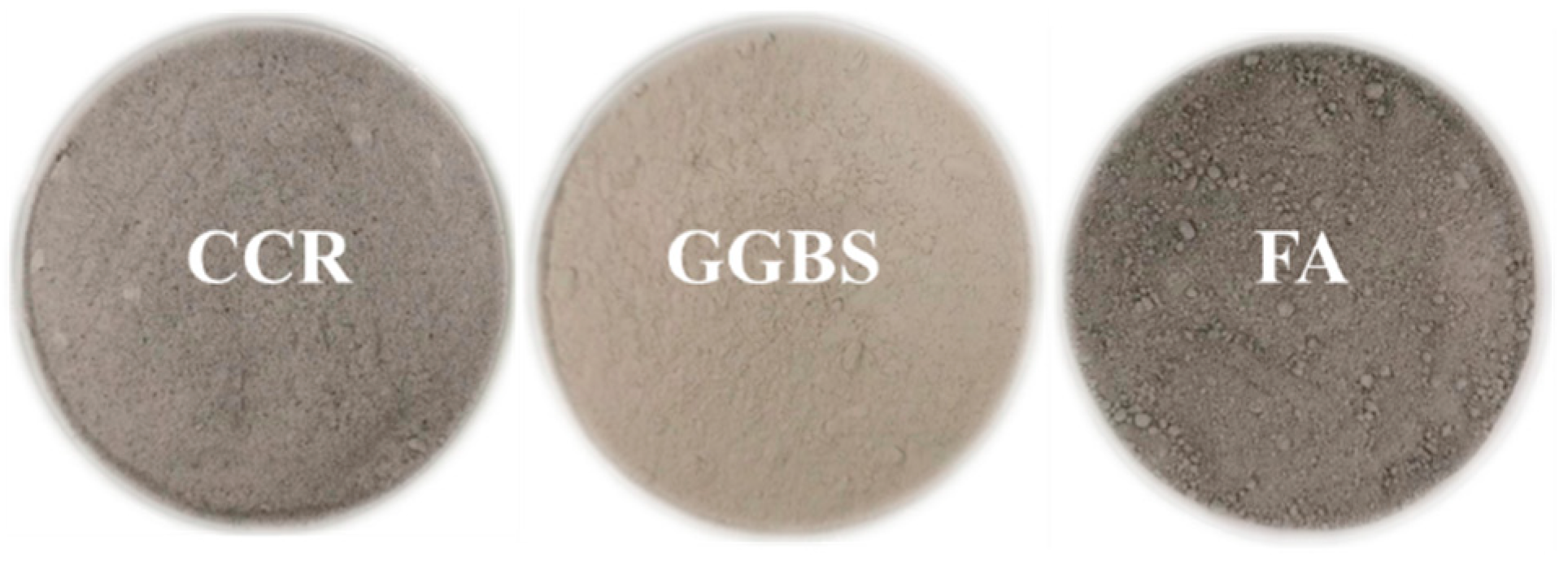
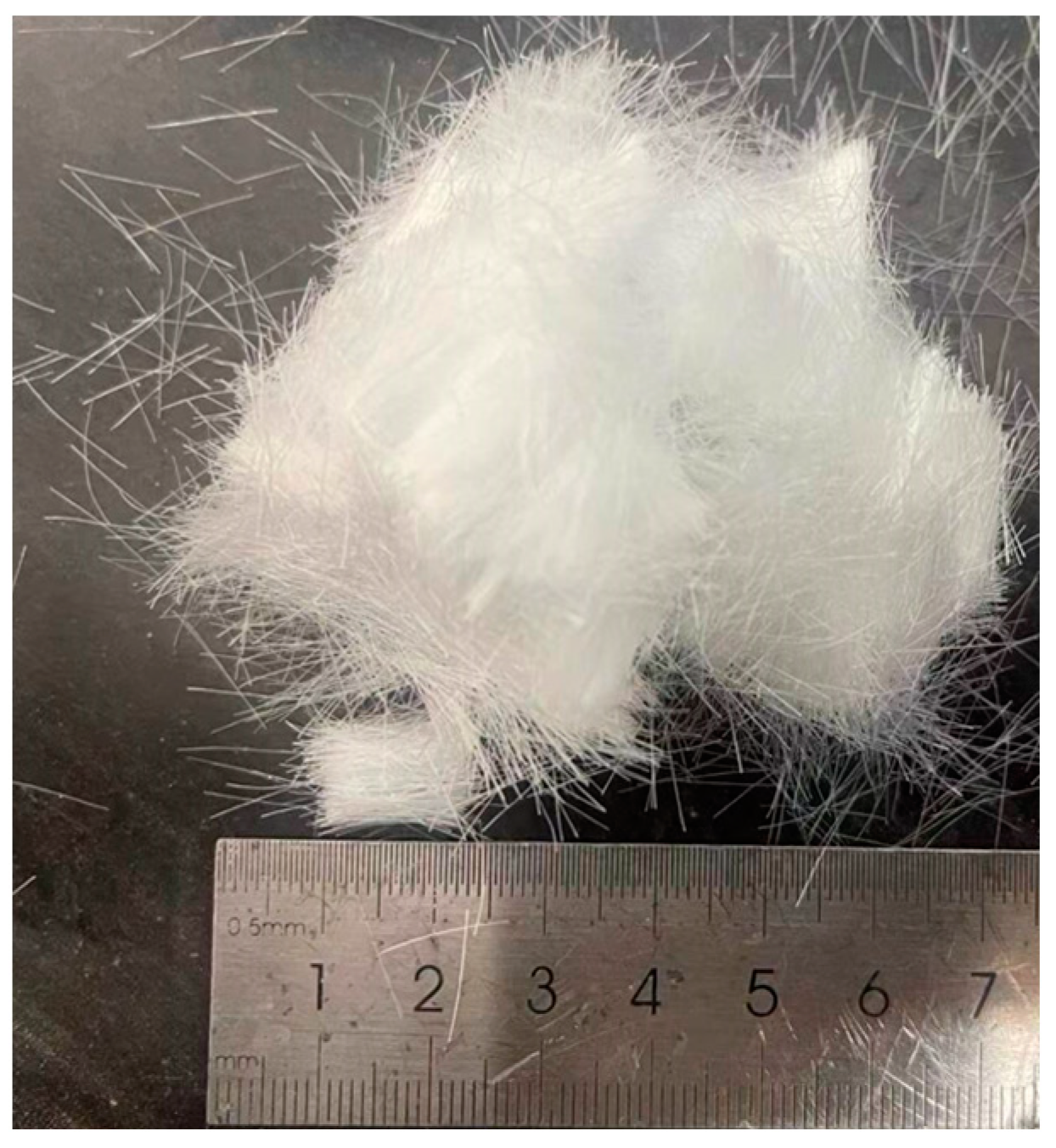





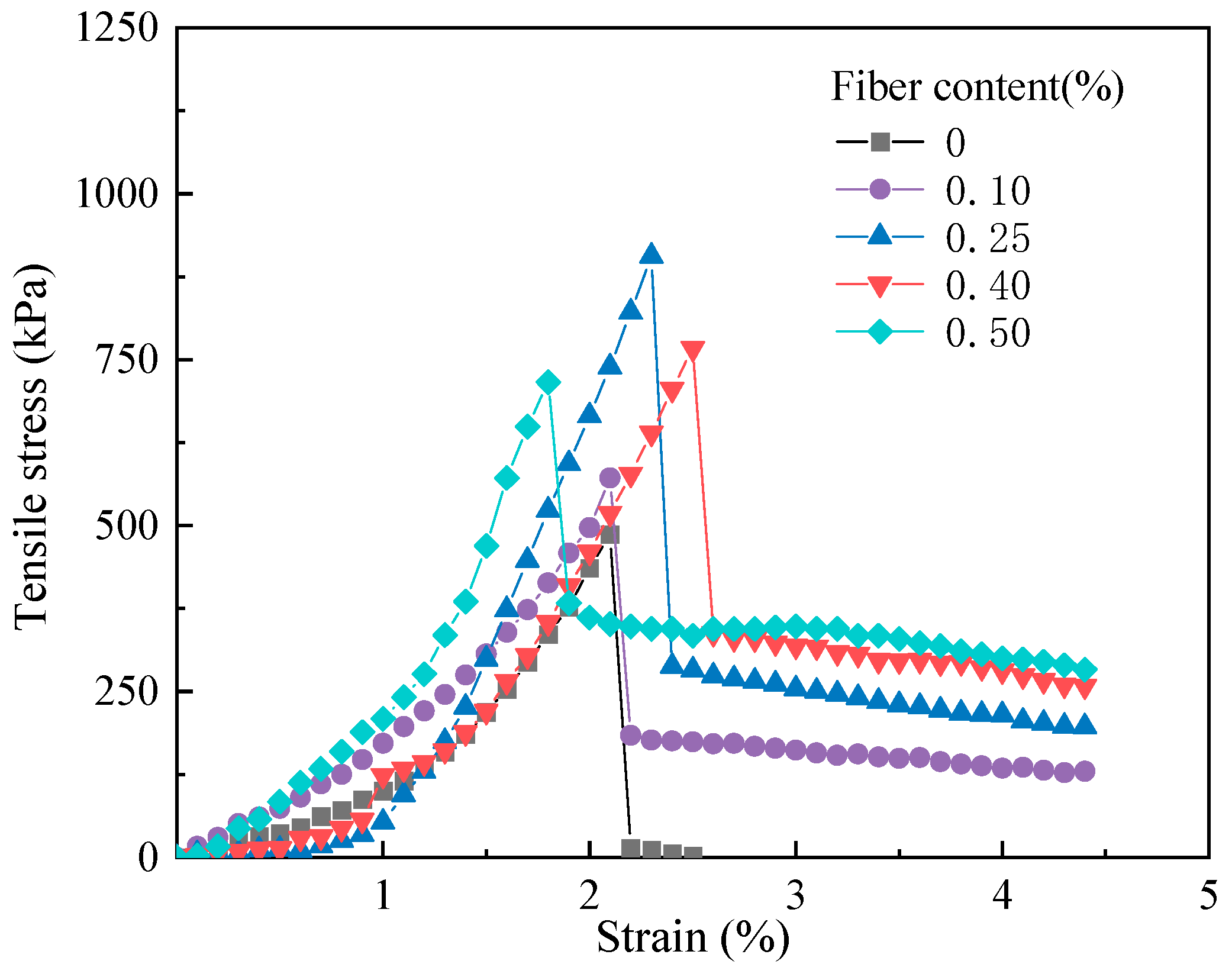

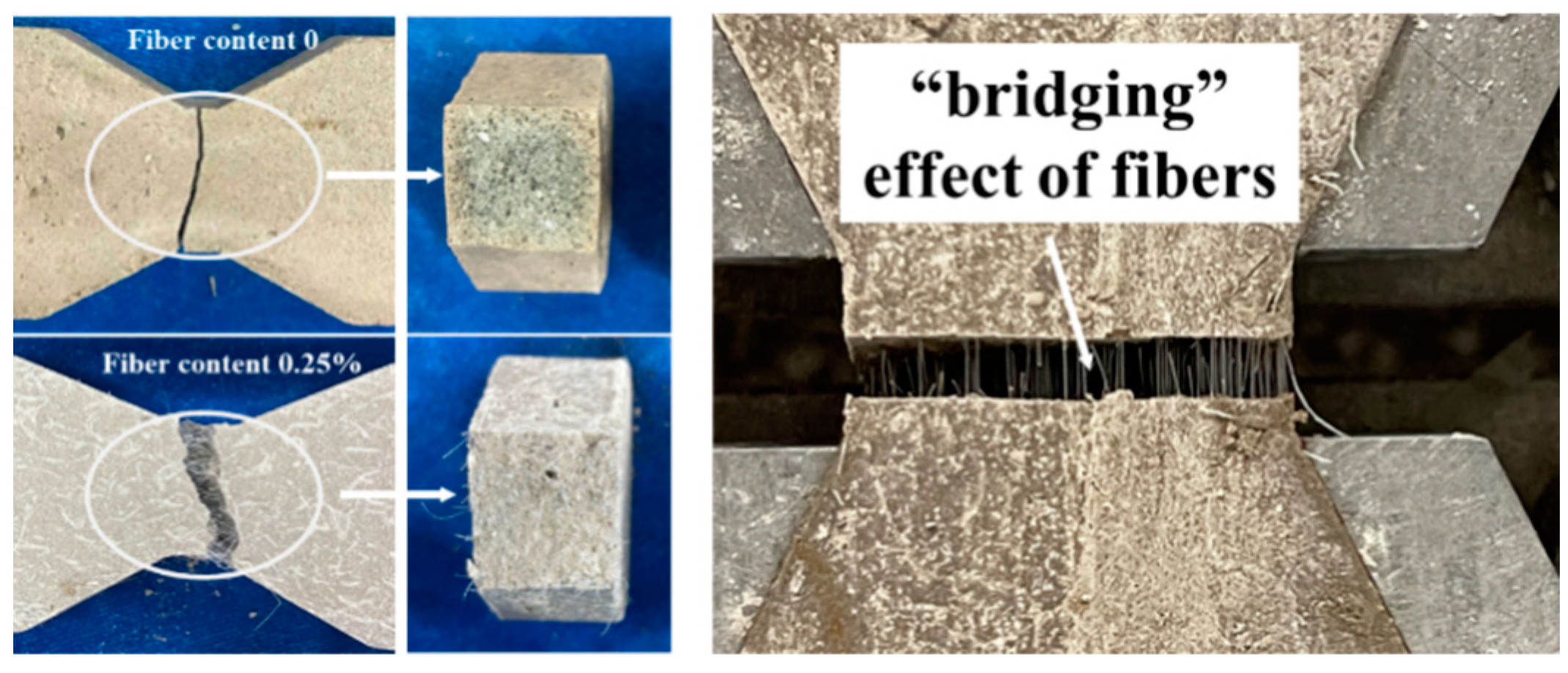
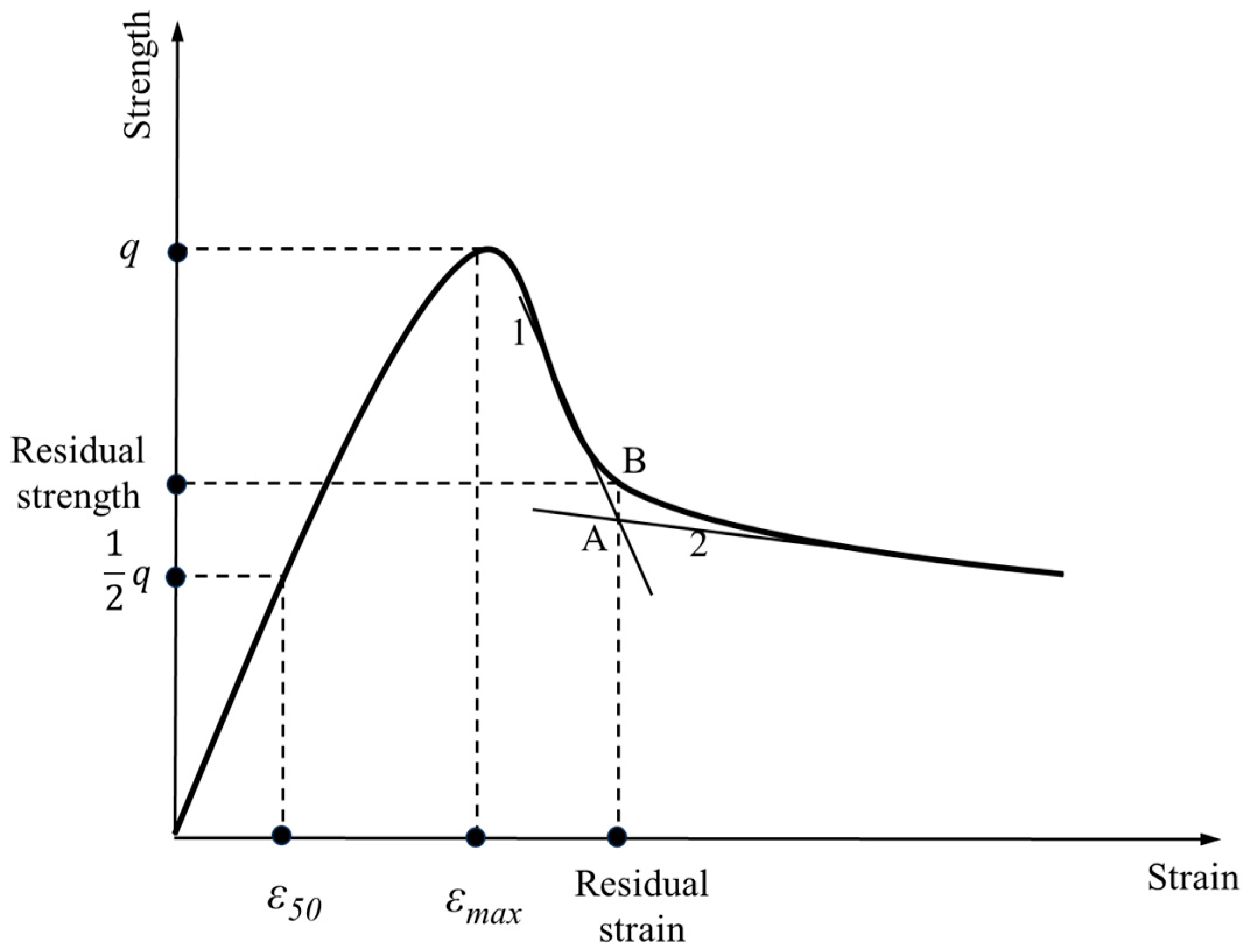
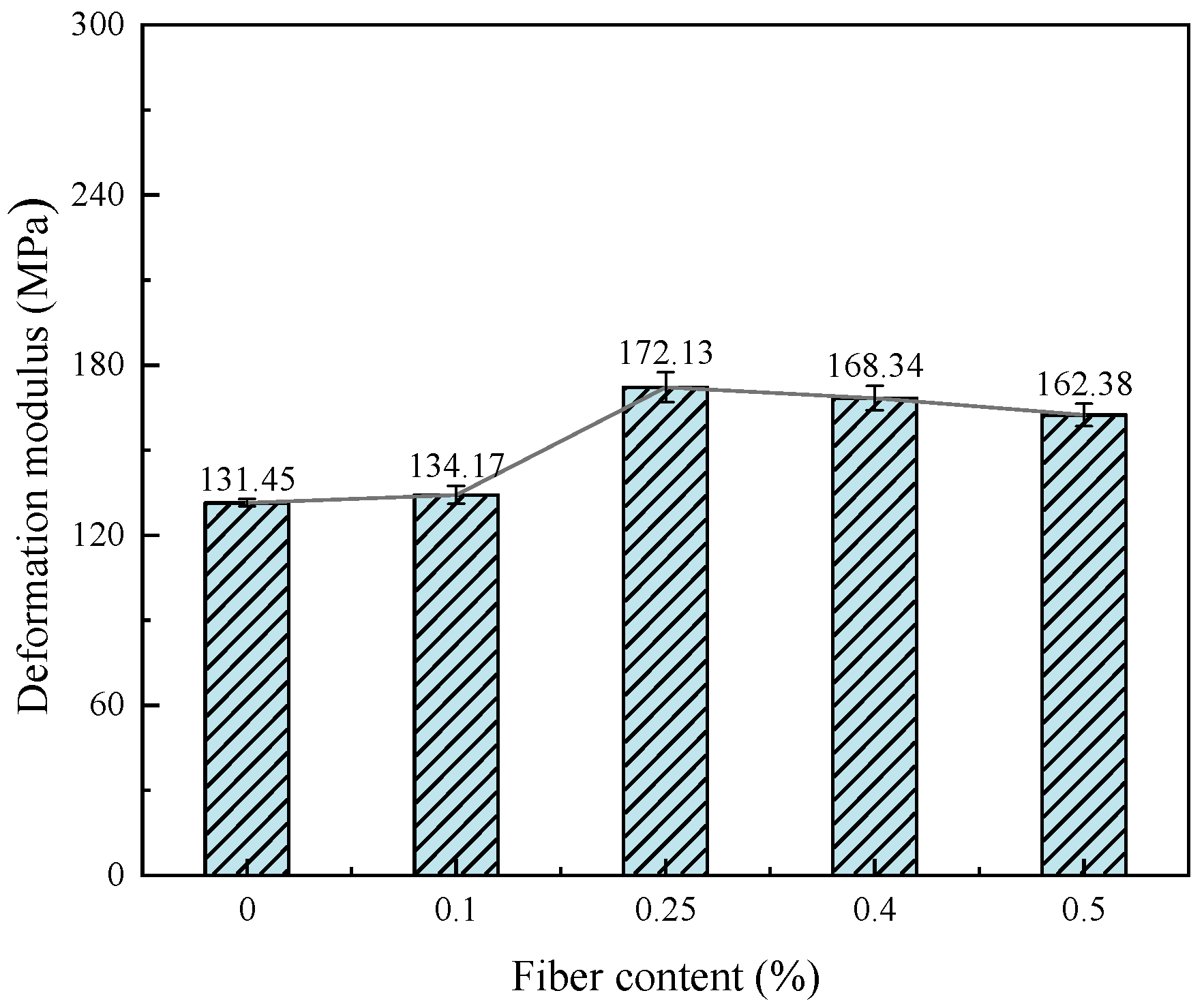
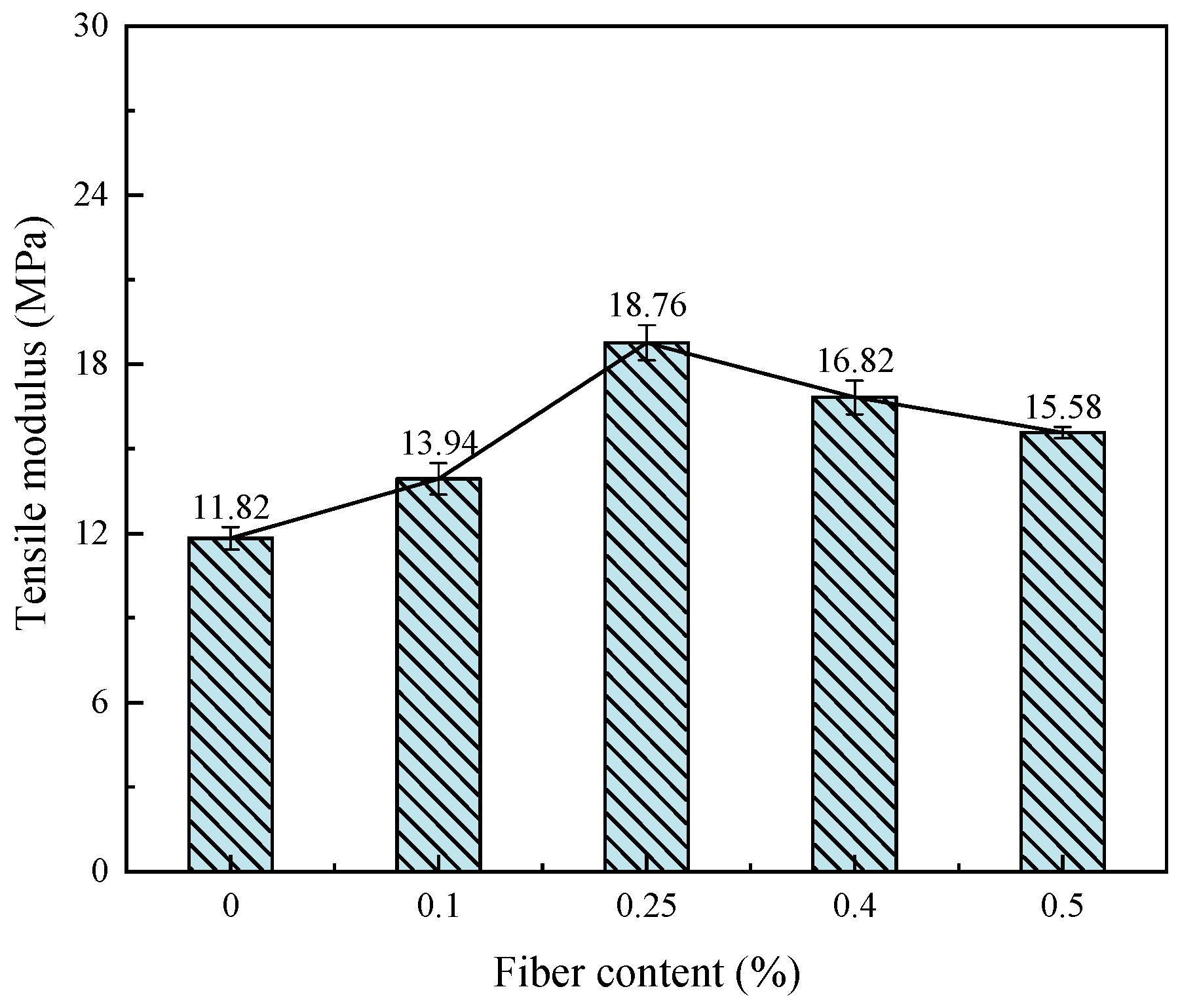
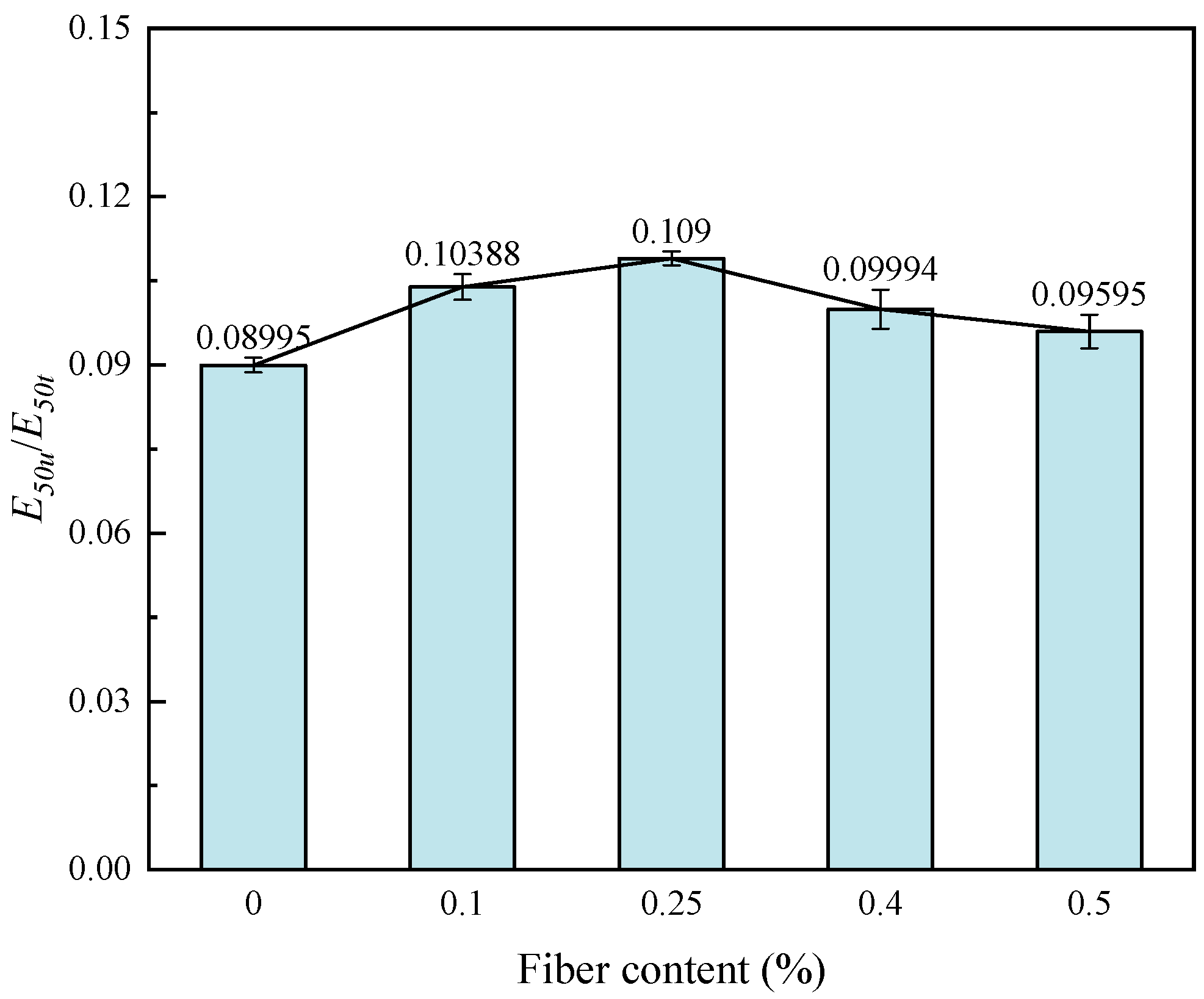
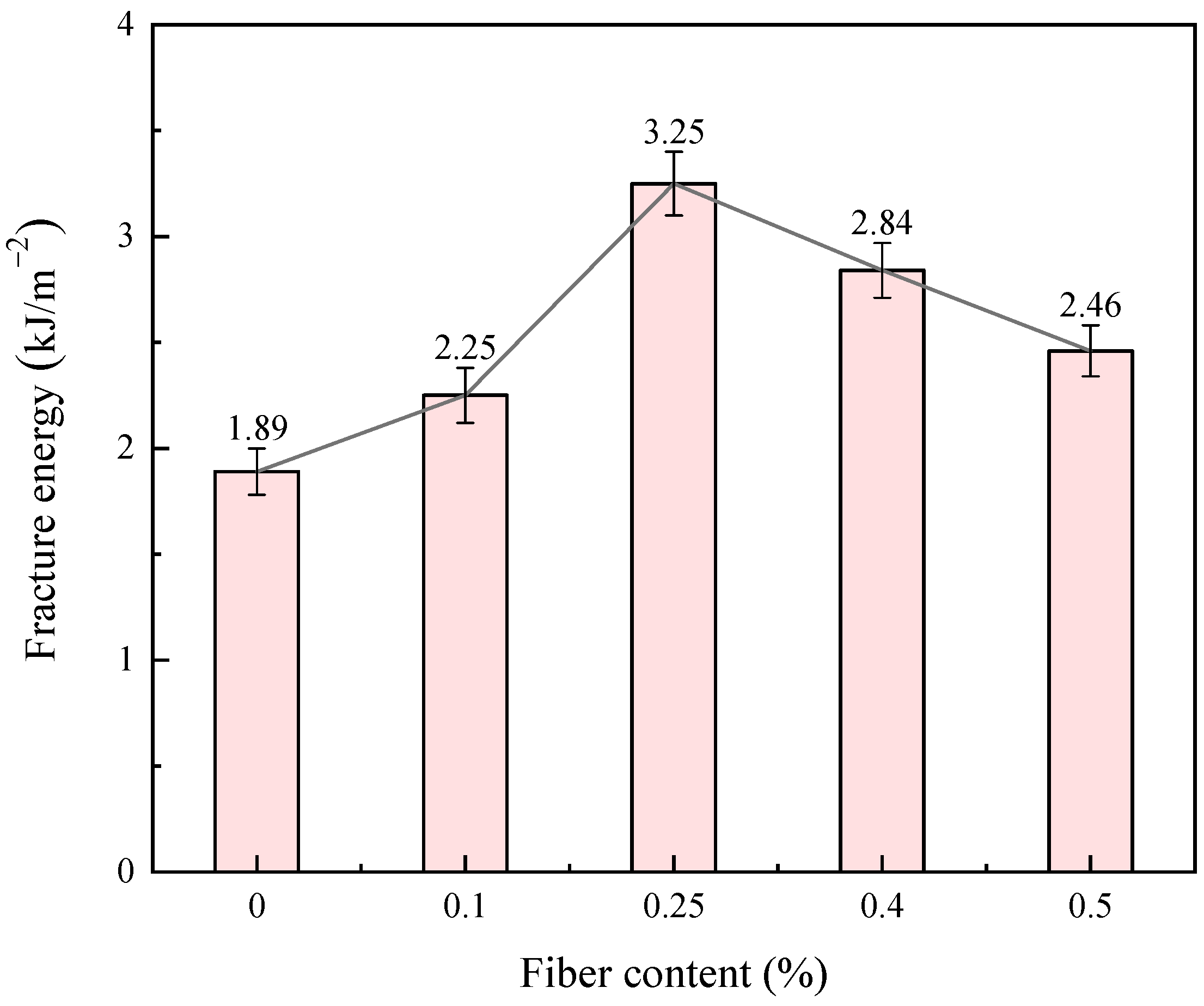


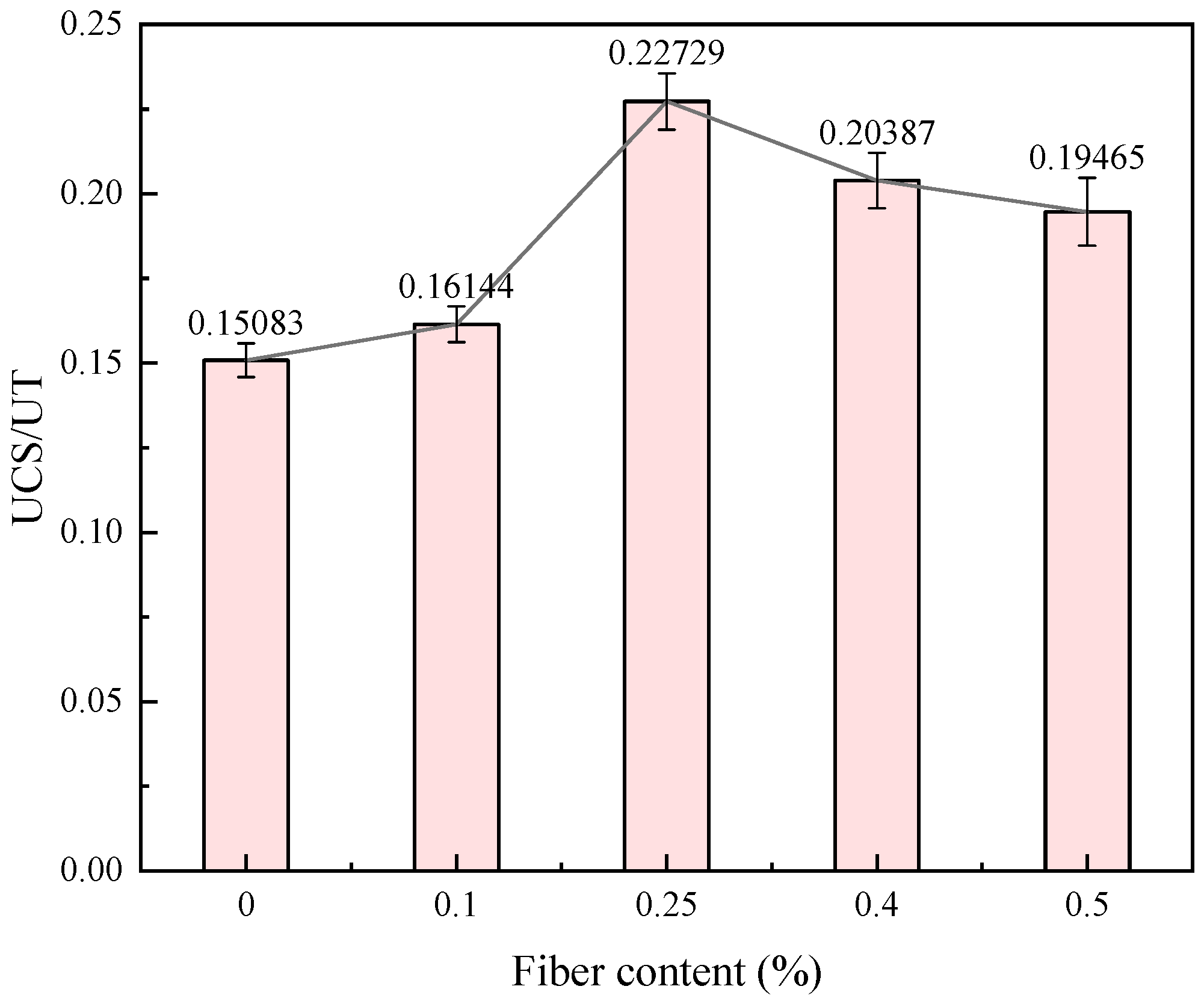
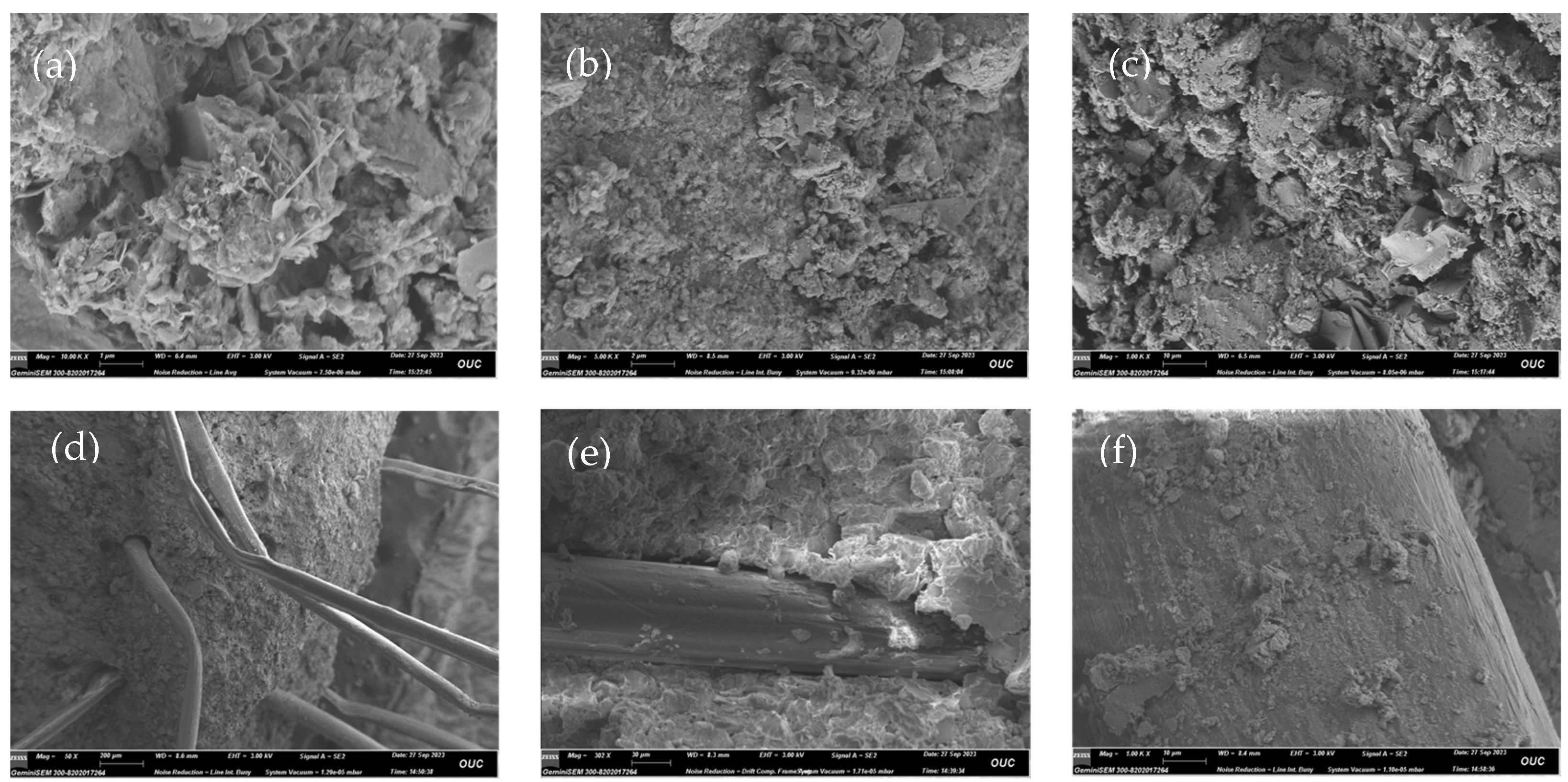
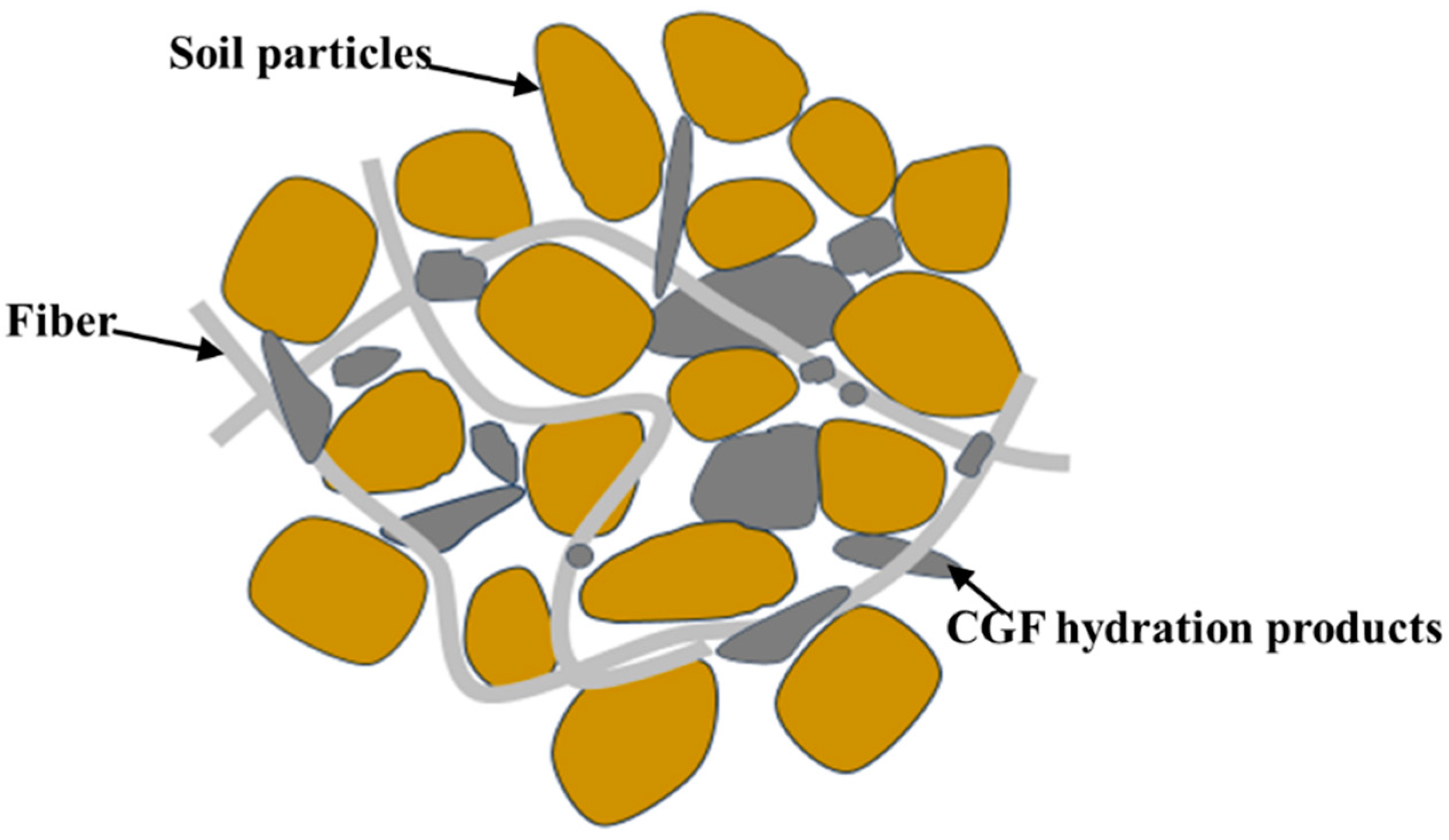
| Particle Density (Gs) | Plastic Limit (%) | Liquid Limit (%) | Plasticity Index (IP) |
|---|---|---|---|
| 2.68 | 26.5 | 29.7 | 3.2 |
| Chemical Component | CaO | SiO2 | Al2O3 | MgO | Fe2O3 | Na2O | K2O | SO3 | P2O5 | |
|---|---|---|---|---|---|---|---|---|---|---|
| Component | ||||||||||
| CCR | 68.8 | 3.59 | 1.56 | 1.21 | 0.09 | / | 0.028 | 0.75 | / | |
| GGBS | 41.17 | 29.47 | 13.61 | 8.04 | 0.425 | 0.676 | 0.354 | 4.90 | 0.03 | |
| FA | 6.60 | 61.29 | 12.66 | 0.02 | 4.48 | 3.75 | 1.32 | 0.66 | 0.01 | |
| Type | Tensile Strength (MPa) | Ultimate Elongation in Percent (%) | Elasticity Modulus (MPa) | Diameter (μm) | Length (mm) |
|---|---|---|---|---|---|
| Fasciculate monofilament | 469 | 28.4 | 4236 | 32.7 | 12 |
| Test Soil | Water Content | Binder Type | Binder Content (%) | Fiber Content (%) | Curing Age (d) | Type of Test |
|---|---|---|---|---|---|---|
| Dongying silt | 1.2wL | CGF | 15 | 0, 0.1, 0.25, 0.4, 0.5 | 28 | Uniaxial tensile test, inconfined compression test, SEM |
Disclaimer/Publisher’s Note: The statements, opinions and data contained in all publications are solely those of the individual author(s) and contributor(s) and not of MDPI and/or the editor(s). MDPI and/or the editor(s) disclaim responsibility for any injury to people or property resulting from any ideas, methods, instructions or products referred to in the content. |
© 2024 by the authors. Licensee MDPI, Basel, Switzerland. This article is an open access article distributed under the terms and conditions of the Creative Commons Attribution (CC BY) license (https://creativecommons.org/licenses/by/4.0/).
Share and Cite
Qiu, X.; Yang, J.; Wu, Y.; Yan, L.; Liu, Q. Effect of Fiber Content on Mechanical Properties of Fiber-Reinforced CGF All-Solid-Waste Binder-Solidified Soil. Materials 2024, 17, 388. https://doi.org/10.3390/ma17020388
Qiu X, Yang J, Wu Y, Yan L, Liu Q. Effect of Fiber Content on Mechanical Properties of Fiber-Reinforced CGF All-Solid-Waste Binder-Solidified Soil. Materials. 2024; 17(2):388. https://doi.org/10.3390/ma17020388
Chicago/Turabian StyleQiu, Xinyi, Junjie Yang, Yalei Wu, Lijun Yan, and Qiang Liu. 2024. "Effect of Fiber Content on Mechanical Properties of Fiber-Reinforced CGF All-Solid-Waste Binder-Solidified Soil" Materials 17, no. 2: 388. https://doi.org/10.3390/ma17020388
APA StyleQiu, X., Yang, J., Wu, Y., Yan, L., & Liu, Q. (2024). Effect of Fiber Content on Mechanical Properties of Fiber-Reinforced CGF All-Solid-Waste Binder-Solidified Soil. Materials, 17(2), 388. https://doi.org/10.3390/ma17020388






